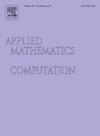Arbitrary-order sensitivity analysis of frequency response functions using hypercomplex automatic differentiation and spectral finite elements
IF 3.4
2区 数学
Q1 MATHEMATICS, APPLIED
引用次数: 0
Abstract
Accurately computing sensitivities of Frequency Response Functions (FRFs) is crucial for analyzing the dynamic behavior of structures by enabling quantifying the impact that variations in geometry, material properties, and boundary conditions have on their dynamic response. However, one of the primary challenges in calculating accurate sensitivities lies in the numerical differentiation required to estimate the sensitivities of the FRFs. This paper presents a new method called the Hypercomplex Spectral Finite Elements Method (HYPAD-SFEM). HYPAD-SFEM combines the HYPercomplex Automatic Differentiation method (HYPAD) with the Spectral Finite Elements Method (SFEM) to compute highly accurate arbitrary-order sensitivities of the FRFs. To demonstrate and verify the method's performance and accuracy, we analyzed a truss structure under a harmonic axial load and compared the results with analytical equations, Finite Differences (FD), and traditional Automatic Differentiation (AD). Excellent agreement was observed between the computed displacements and their sensitivities, considering material properties, geometry, and boundary conditions. The application of HYPAD-SFEM was then extended to a more complex problem by performing shape sensitivity analysis of the dynamic behavior of a phononic lattice. Again, excellent agreement was found between HYPAD, FD and AD. In general, the proposed HYPAD-SFEM ensures high accuracy independent of the perturbation step selection, alleviating FD’s fundamental issues. Moreover, HYPAD-SFEM delivers superior computational performance when compared with traditional AD. Hence, HYPAD-SFEM provides an effective approach for FRF sensitivity analysis, facilitating design optimization, parameter tuning, robustness analysis, and model updating and validation in structural dynamics.
频率响应函数的超复自动微分和频谱有限元任意阶灵敏度分析
准确计算频率响应函数(frf)的灵敏度对于分析结构的动态行为至关重要,因为它可以量化几何形状、材料特性和边界条件的变化对结构动态响应的影响。然而,计算精确灵敏度的主要挑战之一在于估计频响灵敏度所需的数值微分。本文提出了一种新方法——超复谱有限元法。hyperad -SFEM将超复杂自动微分法(HYPercomplex Automatic Differentiation method, HYPAD)与谱有限元法(Spectral Finite element method, SFEM)相结合,计算出高精度的任意阶频响灵敏度。为了验证该方法的性能和准确性,我们对一个桁架结构进行了谐波轴向载荷分析,并将分析结果与解析方程、有限差分法(FD)和传统的自动微分法(AD)进行了比较。考虑到材料特性、几何形状和边界条件,计算位移和灵敏度之间的一致性非常好。然后,通过对声子晶格的动态行为进行形状灵敏度分析,将HYPAD-SFEM的应用扩展到更复杂的问题。同样,在HYPAD、FD和AD之间发现了极好的一致性。总的来说,所提出的HYPAD-SFEM保证了与摄动阶跃选择无关的高精度,缓解了FD的基本问题。此外,与传统AD相比,HYPAD-SFEM具有更好的计算性能。因此,HYPAD-SFEM为FRF灵敏度分析提供了有效的方法,有助于结构动力学中的设计优化、参数整定、鲁棒性分析以及模型更新和验证。
本文章由计算机程序翻译,如有差异,请以英文原文为准。
求助全文
约1分钟内获得全文
求助全文
来源期刊
CiteScore
7.90
自引率
10.00%
发文量
755
审稿时长
36 days
期刊介绍:
Applied Mathematics and Computation addresses work at the interface between applied mathematics, numerical computation, and applications of systems – oriented ideas to the physical, biological, social, and behavioral sciences, and emphasizes papers of a computational nature focusing on new algorithms, their analysis and numerical results.
In addition to presenting research papers, Applied Mathematics and Computation publishes review articles and single–topics issues.

 求助内容:
求助内容: 应助结果提醒方式:
应助结果提醒方式:


